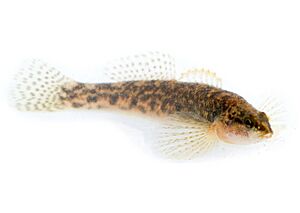Fantail darter facts for kids
Quick facts for kids Fantail darter |
|
|---|---|
 |
|
| Conservation status | |
| Scientific classification | |
| Synonyms | |
|
The fantail darter (Etheostoma flabellare) is a small freshwater fish. It is a type of ray-finned fish called a darter. This fish belongs to the family Percidae, which also includes fish like perches. Fantail darters live in streams across much of North America.
Contents
Where Fantail Darters Live
The fantail darter lives in many parts of eastern North America. You can find them from the Great Lakes and Mississippi River areas. Their range stretches south to South Carolina and northern Alabama. They can even be found as far west as northeastern Oklahoma.
These darters, like many other darter species, prefer smaller streams. They like to live in parts of streams with flat stones and rocks. Large pieces of limestone or shale are especially good places for them. Because they can live in many different places, fantail darters are not considered an endangered species.
Fantail darters are very good at living in streams. They can handle the natural changes that happen in streams with the seasons. Sometimes, their small living areas might change. If this happens, the fish can move downstream to find a new spot. They can also handle changes in oxygen levels in the water.
What Fantail Darters Eat
Fantail darters are similar to other darters in that they have several predators. They are also well-colored to match their homes. This helps them blend in easily with the stream bed and rocks.
Fantail darters eat different things depending on their size. They can eat tiny insects or larger insects and their young. Their food includes small creatures like mayflies, caddisflies, and midge larvae. They also eat tiny crustaceans like copepods and cladocerans.
These darters mainly eat small creatures that live on the bottom of the stream. They prefer shallow, fast-moving parts of streams called riffles. If their living area is damaged or runs out of food, they will simply move to another spot.
How Fantail Darters Handle Changes
During summer, stream water can get much warmer. This causes the water to have less oxygen. Fantail darters are good at handling these temperature changes and low oxygen levels. If a riffle starts to dry up, they can even move out of it.
However, too little oxygen can still be harmful. Without enough oxygen, the fish will eventually die. Pollution in the stream can also cause low oxygen levels. Pollution can also kill the small invertebrates that fantail darters eat.
Life Cycle and Reproduction
Fantail darters lay their eggs in early summer. This happens when the water temperature reaches about 17-20 degrees Celsius. Other darter species lay their eggs earlier. Fantail darter eggs are also usually larger.
Fantail darters have a unique growth period. They do not have a true larval stage. Instead, they start eating just two to three days after hatching. At this point, their fins are already forming. They are born large with well-developed heads, jaws, and teeth. When they first hatch, the young fish stay on the bottom of the stream. They rarely swim up into the water.
As darters grow, they develop features of their sex. They become old enough to breed in one to two years. Most fantail darters do not live longer than four years.
Male Fantail Darter Behavior
Male fantail darters have special first dorsal fins that look like small bulbs. Scientists believe these bulbs are used to mimic eggs. Female darters are more likely to lay eggs with a male who already has a clutch of eggs. This might be why males developed these egg-like fins.
The male looks like he already has eggs, which attracts the female. She will then come under a rock where he has cleared a space. She lays her eggs on the underside of this top rock. Often, several females will add their eggs to one male's nest. This leads to more variety and more young fish.
The male takes care of the eggs while they grow. However, he might eat some of them to keep his energy up. These nests can be easily disturbed. The delicate eggs can be destroyed if a human walks through the stream.
Studies have shown that male fantail darters sometimes eat some of the eggs in their own nest. This is called filial cannibalism. Research found that all male fantail darters are cannibals to some extent. Some males might eat the entire nest of eggs, while others only eat a part of it.
Different Types of Fantail Darters
The fantail darter was first officially described in 1819 by Constantine Samuel Rafinesque. There are two recognized subspecies, which are like different types, of fantail darter:



